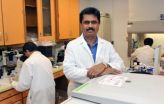(Press-News.org) Part of the answer to how and why primates differ from other mammals, and humans differ from other primates, may lie in the repetitive stretches of the genome that were once considered "junk."
A new study by researchers at the University of Iowa Carver College of Medicine finds that when a particular type of repetitive DNA segment, known as an Alu element, is inserted into existing genes, they can alter the rate at which proteins are produced -- a mechanism that could contribute to the evolution of different biological characteristics in different species. The study was published in the Feb. 15 issue of the journal Proceedings of the National Academy of Sciences (PNAS).
"Repetitive elements of the genome can provide a playground for the creation
of new evolutionary characteristics," said senior study author Yi Xing,
Ph.D., assistant professor of internal medicine and biomedical engineering,
who holds a joint appointment in the UI Carver College of Medicine and the
UI College of Engineering. "By understanding how these elements function, we
can learn more about genetic mechanisms that might contribute to uniquely
human traits."
Alu elements are a specific class of repetitive DNA that first appeared about 60 to 70 million years ago during primate evolution. They do not exist in genomes of other mammals. Alu elements are the most common form of mobile DNA in the human genome, and are able to transpose, or jump, to different positions in the genome sequence. When they jump into regions of the genome containing existing genes, these elements can become new exons -- pieces of messenger RNAs that carry the genetic information.
Although scientists have known for more than a decade that these Alu elements are an important source of new exons in the human genome, it has been more difficult to determine if these new exons are biologically important.
"It's been hard to say whether these Alu-derived exons actually do anything
on a genome-wide level," Xing said. "Our new study says they do - they
affect protein production by altering the efficiency with which messenger
RNA is translated into protein."
Xing noted that in other circumstances, altering the rate of protein production can cause disease, meaning that a mechanism that can affect protein production can have a real impact on the characteristics of an organism.
"This would not be the only mechanism that might differentiate humans from other primates, but our study suggests that the creation of new exons from Alu elements is an important process that contributes to those differences," Xing said.
The UI team, including co-first authors Shihao Shen, doctoral student in the Department of Biostatistics; and Lan Lin, Ph.D., associate in the Department of Internal Medicine, made use of data from a new technology called high throughput RNA sequencing to analyze more than 120 million RNA sequences from human cerebellum. Using this data, the team was able to quantify how often Alu-derived exons were included in the mature RNA sequences, which provide the final blueprint for protein production, and where they were inserted in the genes.
"What we found is that these exons tend to avoid protein-coding regions of the genes and rather they end up in the non-coding region that precedes the protein-coding region, called the five prime untranslated region or 5' UTR," Xing explained. "This is the part of the gene that usually contains regions that help control the stability of the messenger RNA and the efficiency at which the messenger RNA is translated into protein."
Experiments to probe the function of these newly inserted elements proved that Alu exons in this region are able to alter the efficiency of messenger RNA translation, which means they affect how fast protein is produced from the altered genes.
The study also suggests that the effect of the newly created exons might be amplified because of which genes were "targeted" by the Alu exons. The researchers found that Alu exons are highly enriched in genes that code for zinc-finger transcription factors -- proteins that act as master regulators of gene expression and that previously have been linked to human and primate evolution. Because these transcription factors control the expression of thousands of other genes, any changes to the amount of transcription factor available would likely have a cascade effect on the downstream genes.
###
In addition to Xing, Shen and Lin, the team included UI researchers Peng Jiang, Ph.D.; Elizabeth Kenkel; Mallory Stroik; Seiko Sato; and Beverly Davidson, Ph.D., professor of internal medicine, neurology and molecular physiology and biophysics. The team also included James Cai, Ph.D., assistant professor of veterinary medicine at Texas A&M University.
The study was funded in part by grants from the National Institutes of Health and the Roy J. Carver Trust.
STORY SOURCE: University of Iowa Health Care Media Relations, 200 Hawkins Drive, Room W319 GH, Iowa City, Iowa 52242-1009
MEDIA CONTACT: Jennifer Brown, 319-356-7124, jennifer-l-brown@uiowa.edu
END
In an interesting bit of scientific serendipity, researchers at North Carolina State University have found that a chemical compound useful for studying the origins of intestinal birth defects may also inhibit the growth and spread of cancerous tumors.
During the screening of chemical compounds created by NC State chemist Dr. Alex Deiters, developmental biologist Dr. Nanette Nascone-Yoder found one of particular interest to her research: a compound that induced heterotaxia, a disordering or mirror-image "flipping" of internal organs, in the frog embryos she was studying. ...
A daytime sleep could have cardiovascular benefits according to new research by Ryan Brindle and Sarah Conklin, PhD, from Allegheny College in Pennsylvania in the US. Their study, looking at the effect of a daytime nap on cardiovascular recovery following a stress test, found that those participants who slept for at least 45 minutes during the day had lower average blood pressure after psychological stress than those who did not sleep. The work is published in Springer's journal International Journal of Behavioral Medicine.
Long work schedules, shift work, increased anxiety ...
A research study coordinated by Manel Esteller, researcher at Bellvitge Biomedical Research Institute (IDIBELL) has identified a substance that inhibits cancer growth by activating the so‑called "dark genome" (or non‑coding DNA) and micro‑RNA molecules. The study appears this week in the journal Proceedings of the National Academy of Sciences (PNAS).
Human body cells have a genome (the set of our DNA) encoding our proteins such as keratin in the skin or haemoglobin in blood. This genome with encoding DNA represents only the 5% of our genetic material. ...
About 1,200 criminal justice researchers as well as active and retired law-enforcement professionals from around the world are expected to attend the annual meeting of the international Academy of Criminal Justice Sciences, to be held March 1-5 in Toronto. Presentations of the latest research in the field will be made, including research presented by the University of Cincinnati faculty and students.
Recognized at the conference will be UC researchers Bonnie Fisher, professor, and Francis Cullen, distinguished professor. Fisher and Cullen will receive the 2010 Outstanding ...
Researchers from Boston University School of Medicine (BUSM) have found that patients with node negative T3 and T4 non-small lung cancer who underwent chemotherapy before surgery had more than three times the survival rate than patients who only underwent surgery. These findings currently appear on-line in the Journal of Thoracic and Cardiovascular Surgery.
The study looked at a total of 110 patients who underwent surgical resection for invasive T3 and T4 non-small lung cancer between 1979 and 2008. Forty-seven patients received neoadjuvant chemotherapy and concurrent ...
AMES, Iowa - A protein pathway that may hold the secret to understanding Parkinson's disease has been discovered and explained by Iowa State University researchers.
Anumantha Kanthasamy, a distinguished professor of biomedical sciences and the W. Eugene and Linda R. Lloyd Endowed Chair in Neurotoxicology at the ISU College of Veterinary Medicine, has been working to understand the complex mechanisms of the disease for more than a decade. He believes this recent discovery offers hope for the cure.
The research was funded by the National Institutes of Health and is published ...
WASHINGTON, February 28, 2011) – Results from a study published in Blood, the Journal of the American Society of Hematology reveal a close relationship between pulmonary arterial hypertension (PAH)—exceedingly high blood pressure in the arteries carrying blood from the heart to the lungs—and abnormalities of the blood-forming cells in the bone marrow (known as myeloid abnormalities).
The study, which was conducted by a team of researchers at the Cleveland Clinic, showed that blood progenitor cells (cells that are capable of forming white blood cells, red blood cells, ...
A new University of Colorado Boulder study indicates an ancient form of complementary medicine may be effective in helping to treat people with mild traumatic brain injury, a finding that may have implications for some U.S. war veterans returning home.
The study involved a treatment known as acupressure in which one's fingertips are used to stimulate particular points on a person's body -- points similar to those stimulated with needles in standard acupuncture treatments, said CU-Boulder Professor Theresa Hernandez, lead study author. The results indicate a link between ...
ATLANTA –February 28, 2011– A sharp decline in breast cancer incidence rates among non-Hispanic white women in the U.S. after a dramatic drop in the use of postmenopausal hormone therapy did not continue through 2007, according to a new study from the American Cancer Society and the National Cancer Institute. While there are several possible explanations for the recent stabilization, it may indicate that the decrease in breast cancers thought to be related to postmenopausal hormone use has bottomed out. The study appears online in Cancer Epidemiology Biomarkers and Prevention ...
Troy, N.Y. – Benjamin Clough has developed a novel method for eavesdropping on terahertz information hidden in invisible plasma acoustic bursts. The doctoral student at Rensselaer Polytechnic Institute has demonstrated a promising technique that employs sound waves to boost the distance from which researchers can use powerful terahertz technology to remotely detect hidden explosives, chemicals, and other dangerous materials.
Clough, a student in the Department of Electrical, Computer, and Systems Engineering at Rensselaer, is one of three finalists for the 2011 $30,000 ...



